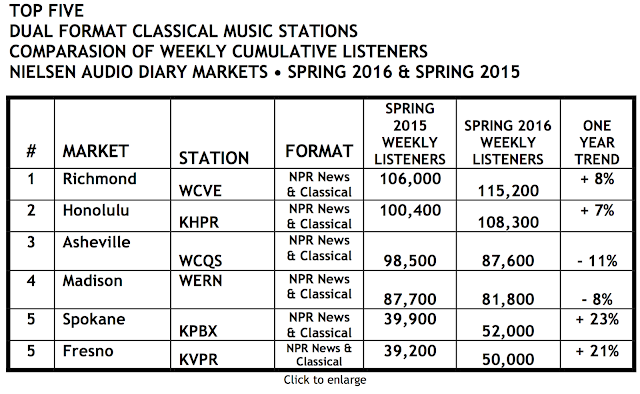Malcolm Gladwell
defines a “tipping point” as "the moment of critical mass, the
threshold, the boiling point.” I’ve also heard it defined as the one snowflake
that causes an avalanche. It is when
something happens and things are never quite the same again.
Today we have a short film about a format change at commercial
classical station WNCN in 1974 that was a radio tipping point. The impact is still
being felt today.
Several decades ago
there were at least 100 commercial classical radio stations. Today you can
count the number of these stations on one hand.
Some commercial stations such as WQXR, WCRB, WCLV, KDFC and KING became
noncommercial public radio stations.
But, many, many other heritage commercial classical stations vanished
from the dial. Classical music fans will
remember KFAC in Los Angeles, WGMS in Washington, DC and WNCN in New York.
THE END OF WNCN
On November 7, 1974
long-time commercial classical station WNCN changed owners and format. At the time WNCN was competing with
then-commercial station WQXR. The new owners – Starr Broadcasting owned by William F.
Buckley – were aware of WNCN’s declining and aging audience and decided to
change the format to rock n roll when they took over.
Classical music
fans were enraged. They formed the WNCN Listener’s Guild and filed a complaint
with the FCC that would force the new owners to change the format back to
classical. After heated discussion, the FCC declined to get involved saying the
marketplace should decide programming, not citizen’s groups or regulators. The
FCC has never gotten involved in format flip since then.
It is time for the
short film to put things in context. You
will hear the final moments of WNCN and the abrupt transition to WQIV, a new
rock station that was broadcast in quadraphonic sound (4 channels of audio). It describes the tipping point, the beginning
of the era when commercial classical radio almost vanished.
Video link: https://www.youtube.com/watch?v=_i8S0b9XdM8
COMMERCIAL CLASSICAL STATIONS & THE
TIPPING POINT
The FCC’s decision
to stay out of program and format changes encouraged the sale of many FM
stations because it ended the uncertainty of costly and time consuming legal
challenges. But there were other
factors.
By the late 1970s
FM listening exceeded AM as mainstream music formats like Album Oriented Rock
(AOR) and Country zoomed in popularity.
This caused FM stations to rise in value. Many older owners sold their stations to a
new breed of corporate station owners.
Increasingly
sophisticated audience research showed that even though commercial Classical stations
had lots of listeners, most of them were outside the 18-34 and 24-55
demographics that advertisers wanted to reach. More and more commercial Classical stations
vanished every year.
Around the same time there was also a
tipping point for another commercial radio format: So-called “Beautiful Music.” BM is still lampooned by comedians today
as “elevator music" -- cheesy instrumental versions of Stairway to Heaven. But, in their heyday, BM stations were highly profitable
and reached large numbers of listeners.
Like Classical listeners, most of BM’s listeners were older than the
desired demographics.
I witnessed this
tipping point first-hand when I worked for Transtar and Unistar in the mid to
late 1980s. WEAZ a/k/a Easy 101 (now
WBEB) in Philadelphia was the most influential BM station. In 1988 WEAZ dumped BM and began airing
Transtar’s Format 41, a format designed to reach an audience whose average age
was 41. In the following year almost
every BM station in the nation flipped to another format.
SIMILARITIES TO NONCOMMERCIAL CLASSICAL
TODAY
One vital
difference between commercial and noncommercial radio is that most noncoms are
mission oriented. This fact alone keeps many of the current noncom Classical
music stations on the air.
Classical noncoms
are doing well right now. For instance,
we reported yesterday that 72% of Classical stations in Nielsen Audio Diary
markets increased their number of weekly cumulative listeners from Spring 2015
and Spring 2016.
But noncom
Classical station audiences skew very old. Tom Thomas of the State Resource
Group (SRG), sponsor of Classical Music Rising (CMR), presented the chart on
the right at CMR’s recent meetings in Phoenix. Fact: Noncom Classical radio
listeners are quite old.
Given this reality,
CMR is making valiant efforts to reach new younger listeners via digital
platforms. CMR is also examining new revenue opportunities to offset expiring
current members. The key question is whether their efforts will postpone or
solve what appears to be an upcoming tipping point of Classical music on public
radio.






























